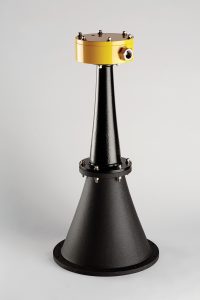AirSweep Solves Biggest Bulk Material Processing Challenges
Comments Off on AirSweep Solves Biggest Bulk Material Processing Challenges
Reliable material flow is critical for efficient bulk material processing. Material blocks slow down production and waste time and money. Stagnant material can also be contaminated or affect batch consistency.
So, the biggest challenge of bulk material processing is to achieve on-demand, first-in/first-out material flow. Unfortunately, that is easier said than done.
Why is it hard to achieve reliable material flow?
There is no single, simple formula for achieving good material flow. You have to consider many factors, some of which cannot be controlled or changed.
- Some materials have problematic flow patterns, because of their chemical or molecular structure, weight, and how they react to moisture.
- Cohesive and adhesive force, which cause particles to stick together and block the discharge
- Cohesive strength and internal friction affect how strong the material block is
- Bulk density, which affects how easily it flows because of gravity
- Particle size and shape
- Tendency to absorb moisture
- Angle of repose, which is directly related to the flow rate
- Flow patterns are difficult to predict. Product formulas will include a variety of materials, which all have their own particle characteristics and densities. If a company decides to change its formula it can encounter a material flow problem.
- Some vessels are not designed for efficient material flow. The slope or angle of the vessel and the size and shape of the discharge outlet can affect the rate of flow. Unfortunately, not all equipment is customized for the flow properties of the materials.
- Plant humidity and moisture can affect materials. This is especially true for countries with high humidity or materials that are hygroscopic or have a tendency to attract moisture.
- Material flow problems can occur at any stage of bulk material processing. Some materials can settle and become compact during storage, while others will flow well until it is mixed with other materials.
What are the most common material flow problems?
The most common bulk material processing problems are bridging, ratholing, and segregation.
Bridging occurs when material forms a large arch above the vessel discharge and stops the material flow. It can be caused by large particles interlocking, or smaller particles bonding together because of the moisture, temperature, particle shape, or concentration of fines.
Ratholing occurs when stagnant material builds up on the vessel walls and thus restricting the passage of materials. Aside from slowing down the flow, it also causes material waste and possible contamination.
Segregation is the uneven distribution of components of bulk material because of differences in their physical or chemical properties. This can lead to inconsistent formulas, which can affect product quality and safety.
What can improve material for bulk material processing?
AirSweep eliminates bridging, ratholing, material segregation, and other flow problems. It guarantees on-demand, first in/first out flow, and has lower energy and maintenance costs than other flow aids.
AirSweep is used in thousands of bulk material processing plants worldwide. It is proven effective for even moist, sticky, and heavy materials, and has helped many customers increase production, lower costs, and protect product quality.
Contact us for more information about AirSweep, and how it can benefit your plant operations.
Benefits of AcoustiClean Sonic Horns
Comments Off on Benefits of AcoustiClean Sonic Horns
AcoustiClean Sonic Horns provide several material flow benefits that plant managers need. AcoustiClean Sonic Horns produce high-energy, low-frequency sound vibrations that disperse dry material. It can help clean vessels and equipment like silos, hoppers, heaters, and fans to minimize downtime and material build-up.
Sonic horns are often used in industries like cement, petrochemical, and power generation. However, it can benefit any process where material build-up can occur.
AcoustiClean reaches blind spots
Manual cleaning can be tedious, time-consuming, or even impossible in inaccessible areas. AcoustiClean’s powerful sound vibrations can clear out material in seconds, even in equipment that is hard to clean (i.e, pipes or baghouses) or are in hard-to-reach locations. It can also reach blind spots that mechanical soot blowers and rapping systems often miss.
No equipment damage
Unlike other cleaning systems that use pressurized air, sound vibrations don’t damage sensitive equipment like tubes.
Customizable for different environments
AcoustiClean can be made of either stainless steel or cast iron. Stainless steel can be sanitized easily and is suitable for food and sanitary applications. Cast iron can withstand temperatures up to 2000ºF.
A manufacturer of building materials sends waste materials like wood flakes and wet bark to a boiler furnace. However, the soot build-up affected the boiler’s heat transfer efficiency and clogged the equipment.
They tried installing soot blowers, but these melted in the furnace’s high temperatures. The pressurized air also damaged the tubes, further adding to their equipment costs.
The manufacturer replaced soot blowers with AcoustiClean Sonic Horns and saw instant results. With the soot removed, the furnace temperatures remained steady and allowed optimum production time.
AcoustiClean is Versatile
AcoustiClean Sonic Horns can be mounted and hung on practically any kind of equipment.
- Silos
- Hoppers
- Boilers
- Cyclones
- Baghouse Filters
- Super Heaters
- Air Heaters
- Economizers
- ID Fans
- ESPs
- Ducting
- SCRs
Low Maintenance
The AcoustiClean system is designed to be efficient and very easy to maintain. The only parts that need to be replaced are the sound generators (every few years) and the titanium diaphragm (the only moving part, which is replaced yearly).
Contact us for more information about AcoustiClean Sonic horns, and how they can benefit your plant operations.




